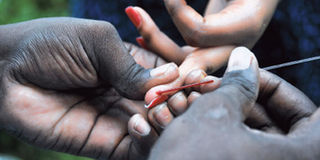US-funded anti-HIV faces staff shortage

A health worker takes a blood sample to test for HIV. PHOTO | FILE
What you need to know:
- The problem has been compounded by lack of or poor distribution of testing kits in three regions where HIV/Aids prevalence has been fuelled by rising populations
Arusha. Low HIV testing and shortage of staff are among challenges facing a United States-supported programme aimed to eliminate paediatric HIV in Shinyanga, Geita and Simiyu regions.
The problem has been compounded by lack of or poor distribution of testing kits. HIV/Aids prevalence in the three regions has been fuelled by rising population around the townships and mining centres.
“The situation is worrying also because of the high level of poverty,” said Mr Laurean R. Bwanakunu, the executive director of Ariel Glaser Pediatric Aids Health Initiative (AGPAHI).
Statistics from the Tanzania HIV & Aids and Malaria Indicator Survey (THMIS) shows that Shinyanga, Simiyu and Geita regions have a HIV prevalence of 7.4 per cent, 4.6 per cent and 3.5 per cent respectively with the infected totalling 247,330.
The programme took off in September 2011 and by December last year, it had managed to reach and provide 82,285 clients with HIV care and treatment services, of whom 5,189 were pedriatic clients.
Of the three regions, Shinyanga has the highest number of people living with HIV (113,575), followed by Simiyu (72,871) and Geita which had 60,883 people living with HIV when the programme took off.
But a report presented during a meeting of the programme implementers which took place in Arusha indicated that Kahama District in Shinyanga had the highest HIV/Aids prevalence in the country.
The fast urbanizing district due to mining and other economic activities presently has a 9 per cent prevalence ahead of the current national rate of 5.1 per cent. The latter had dropped from 7 per cent in 2008.
With one million people, Kahama is the second most populous district in the country after Kinondoni and is only with three councils; Ushetu, Msalala and Kahama town and has a record 54 wards.
Mr Bwanakunu said under the programme being implemented with a $4 million from the US, at least 35,000 in the three regions were on medicine. Under the programme every pregnant woman has to be tested on her HIV status.
The programme is supported by the United States Agency for International Development (USAid), Centre for Disease Control and Prevention (CDC), United Nations Population Fund (UNFPA) and US President’s Emergency Plan for Aids Relief (PEPFAR).
“The district councils are fully involved in the implementation of the programme. Among these is capacity building for the local authority workers,” he pointed out.
The 13 district hospitals and three hospitals in the zone are also provided with grant under the programme which has 77 care and treatment sites in the three regions.




